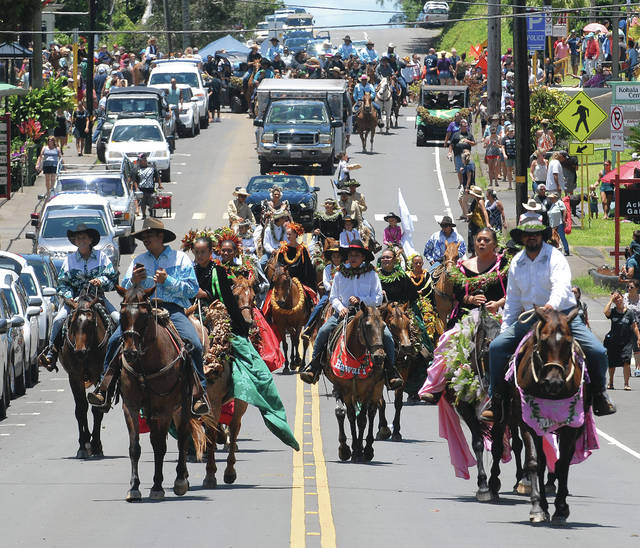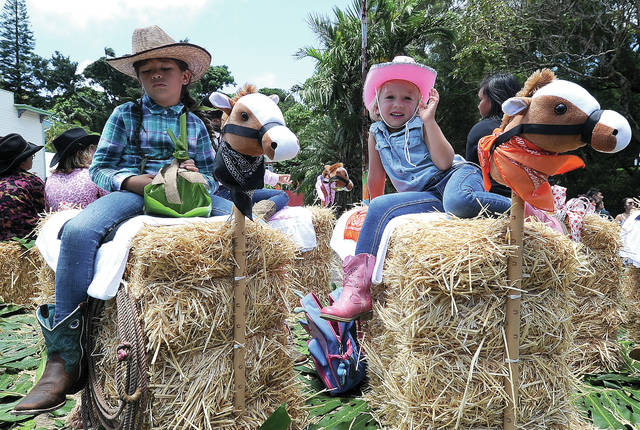KAPAAU — Spectators and planners of the Kamehameha Day Celebration in North Kohala felt Hawaii Island saved its best for last Sunday.
KAPAAU — Spectators and planners of the Kamehameha Day Celebration in North Kohala felt Hawaii Island saved its best for last Sunday.
The annual ceremony in Kapaau honoring King Kamehameha I, who united the Hawaiian Islands, is unique in two ways. First, the celebration is always held on June 11, the actual date of the king’s birth.
Second, the heart of the ceremony is situated in front of the original King Kamehameha I statue outside of the North Kohala Civic Center, close to the king’s birthplace. The festivities literally stop traffic on Akoni Pule Highway, and thereby the entire Kohala region, until the procession is complete.
“Everybody wants to be us,” said Boyd Bond, a historian and Sunday’s master of ceremonies. “In Kohala, we don’t care when the 11th falls. We stop the day and we honor the king. Everybody else waits until Saturday. They do it and it’s more of a commercial thing. … (Here) it’s grassroots, it’s from the community, it’s from the heart.”
Several in attendance echoed Boyd when asked why they chose the northern edge of the Big Island as the backdrop for their holiday celebrations.
“Given the choice, I chose to come here because it’s tradition,” said David Clark, a part-time resident of Waikoloa. “I love the story behind the statue itself.”
Commissioned in the late 1800s, sculptor Thomas Gould began work on the statue in Italy and sent it to be cast in Germany, after which it made a stop at a world fair in Paris before being shipped to Hawaii.
Because of a fire, the ship that carried the statue sunk off of the Falkland Islands. The statue remained under water until it was accidentally discovered by a fisherman, winding up in the hands of the harbor master. It was later seen by a British captain heading to Hawaii, who bought it from the harbor master and sailed it into Honolulu.
It was then purchased by Walter Murray Gibson, a legislator who eventually became Prime Minister, and who initially had the idea to commission the statue. It was decided the statue should be sent to North Kohala, where it remains today.
There are some parallels to draw between the statue’s journey to Kohala and the journey of King Kamehameha I as an infant, which spectator Darnell Caravalho said touches the history of every area in the region.
“Today is part of Kohala. Growing up here, this is us,” she said. “It’s touching for me to think I’m part of this. You hear the stories of how each part of Kohala got its name and it all has to do with Kamehameha’s birth.”
The statue couldn’t evade damage as it made the trek to Kohala, but there was a feeling Sunday that the peril and hardship it endured contribute to its character.
Again, there are similarities with the king himself, who was born and grew up under the threat of death, separated from his peers. He was renamed Kamehameha by one of his warrior surrogates, which means “the lonely one.”
The damages were eventually fixed, although Gould made a few noticeable errors in his initial design that couldn’t be undone. He used Roman conqueror Julius Caesar as a model, which is why the statue’s right hand reaches out with its palm facing up.
Boyd explained that to Hawaiians, the gesture means something quite different than it did in Europe during Caesar’s time.
“I believe the saying goes, ‘You don’t beg with your hand turned up, you turn your hand down to the earth and grow food,’” Boyd told the crowd.
The visible sash across the warrior’s chest would also have traditionally been worn underneath his cape.
Despite its inaccuracies, the statue is ripe with history and meaning, particularly in Kohala, and thus serves as the prevailing symbol of the king’s eminence and, by extension, the distinction of the Hawaiian culture.
This was more evident nowhere than in the elaborate draping of the lei across the king’s outstretched arms Sunday morning. Boyd explained that the dozens of enormous lei, intricately woven by several community individuals and groups, weren’t merely gifts.
They were offerings.
“If I make an any-kind fast lei and throw it up there, everybody is going to know,” Boyd said. “So they want to take time, do the double strand, make it very nice. It’s an example of their work and it’s in public.”
It’s all about mana, he continued.
“Your mana, your personal reputation grows because you gave this,” Boyd explained. “If there was only two or three lei on the king, his mana would be weak. But look at all the lei on the king. So his mana grows also by the receiving of so many offerings.”


